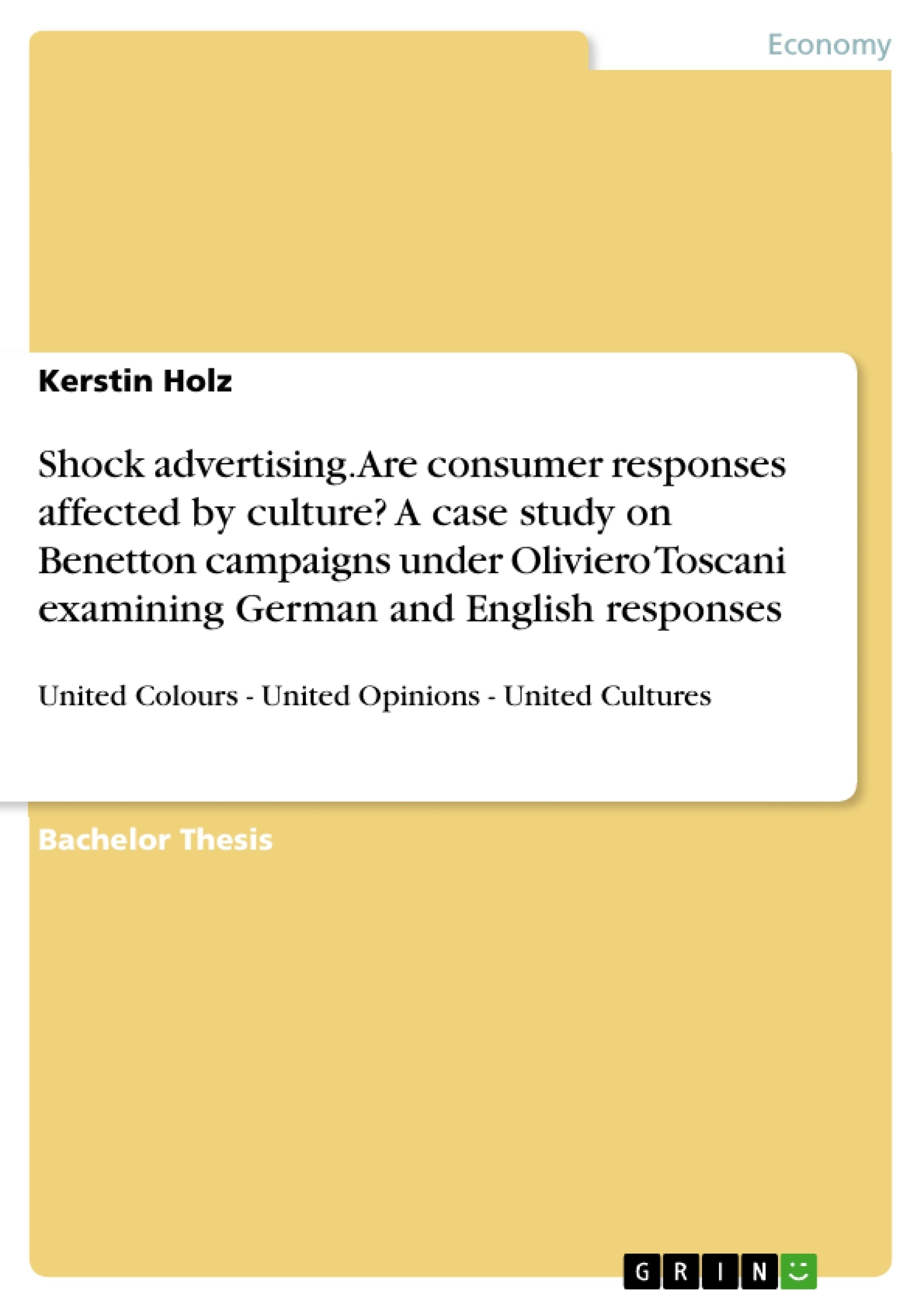This research aimed to show whether responses to shock advertising campaigns are influenced by culture
The aim and objectives for this research included to analyse the techniques and impact of shock advertising, evaluate the cultural characteristics of Germany and England in relation to the perception of advertising, analyse the impact of four selected campaigns on Benetton’s financial performance and to critically evaluate the extent to which culture influences the acceptance of shock advertising through focus groups/questionnaires. The gathered data from questionnaires and focus groups was then compared and contrasted against the findings from secondary sources as well as against each other.
The comparison of the three types of research showed that differences between both cultures exist. Both countries have different approaches towards the Benetton campaigns:
Germany strategically and England emotionally. This does not necessarily mean they respond differently to them, although research has shown that, as opposed to data gathered in the secondary literature, Germany responded more tolerantly and openly to the campaigns than expected, whereas England, expected according to the secondary literature to understand advertising based on creativity, did just the opposite.
The English group rated the shock factor more strongly than the German group, proving that responses to shock advertising are dependent on cultural influences.
The results from this research therefore show that responses to these campaigns are affected by culture especially in emotional campaigns such as the Benetton ones and companies should take these differences into account. Obviously it is cheaper and easier to run a standardized global campaign; however, this does not take different cultures in different countries into account which might harm brand perception due to misunderstandings and different decoding approaches.
The phenomenon of globalisation will be of great interest for further research as it brings cultures closer together. The research, over a larger timeframe, might show how cultures are becoming more similar and therefore a standardised advertising strategy might be more useful than ever.
Inhaltsverzeichnis (Table of Contents)
- List of Abbreviations
- Rationale
- Introduction
- Literature Review
- Evaluating current literature on shock advertising
- Methodology
- Secondary data
- Primary data
- Sampling
- Pilot study
- Focus groups
- Research process
- Questionnaire session
- Chi-square analysis
- Chapter One
- Introduction to the advertising culture and Benetton
- The German customer and perspective on advertising
- The English customer and perspective on advertising
- Benetton's advertising and finances
- Oliviero Toscani's philosophy of advertising
- Chapter 2
- Research in Germany
- Chapter three
- Research in England
- Analysis
- Chapter four
- Focus group discussions in Germany and England. The campaigns
- First impressions
- Advertising strategy
- Chapter five
- Conclusions and Recommendations
- Triangulation comparison
- Secondary research
- Questionnaires
- Focus groups
- Conclusion
- Critical review of the research process
- Recommendations
Zielsetzung und Themenschwerpunkte (Objectives and Key Themes)
This research aims to explore the influence of culture on consumer responses to shock advertising campaigns. The study focuses on the clothing retailer Benetton, utilizing campaigns directed by Oliviero Toscani during his tenure from 1982-2000.
- The impact of shock advertising techniques on consumer responses.
- Cultural differences in the perception of advertising between Germany and England.
- The influence of culture on the acceptance of shock advertising.
- The impact of selected Benetton campaigns on the company's financial performance.
- The potential for globalization to influence the effectiveness of standardized advertising strategies.
Zusammenfassung der Kapitel (Chapter Summaries)
- Chapter One: This chapter introduces the advertising culture and Benetton, providing background information on the company and its advertising strategies. It also explores the perspectives on advertising held by German and English consumers, highlighting potential cultural differences. The chapter concludes with a discussion of Oliviero Toscani's philosophy of advertising, which emphasizes the use of shock tactics.
- Chapter Two: This chapter focuses on the research conducted in Germany, examining consumer responses to Benetton's shock advertising campaigns. The chapter analyzes the collected data and explores the potential influence of German cultural values on consumer perceptions.
- Chapter Three: Similar to Chapter Two, this chapter presents the findings of the research conducted in England. It analyzes the data collected from English participants and examines the impact of English cultural influences on responses to Benetton's advertising campaigns.
- Chapter Four: This chapter compares and contrasts the findings from the focus group discussions conducted in Germany and England. It analyzes the participants' initial impressions of the campaigns and explores their understanding of the advertising strategies employed by Benetton.
Schlüsselwörter (Keywords)
The core concepts of this study include shock advertising, cultural influences, consumer responses, Benetton campaigns, Oliviero Toscani, Germany, England, advertising perception, and globalization.
- Quote paper
- Kerstin Holz (Author), 2006, Shock advertising. Are consumer responses affected by culture? A case study on Benetton campaigns under Oliviero Toscani examining German and English responses, Munich, GRIN Verlag, https://www.grin.com/document/69778



